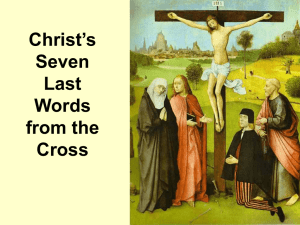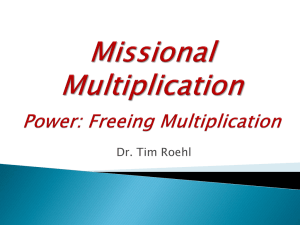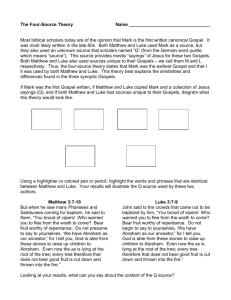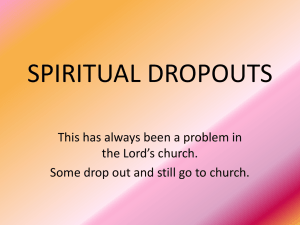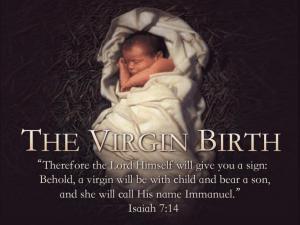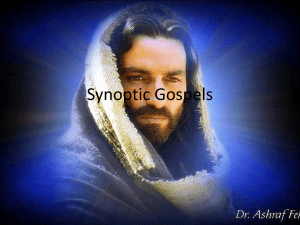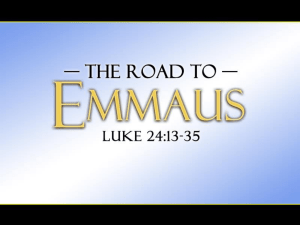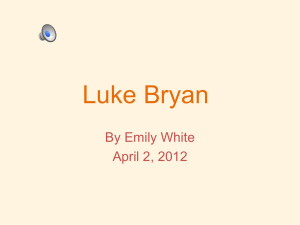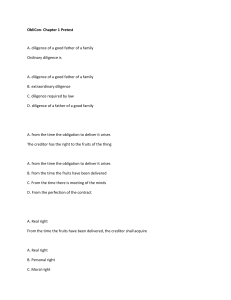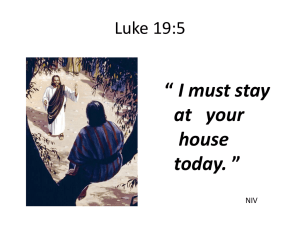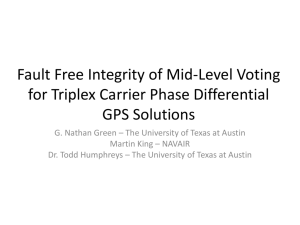1 Unavoidable Uncertainties on Q and Mark In this brief note a few
advertisement
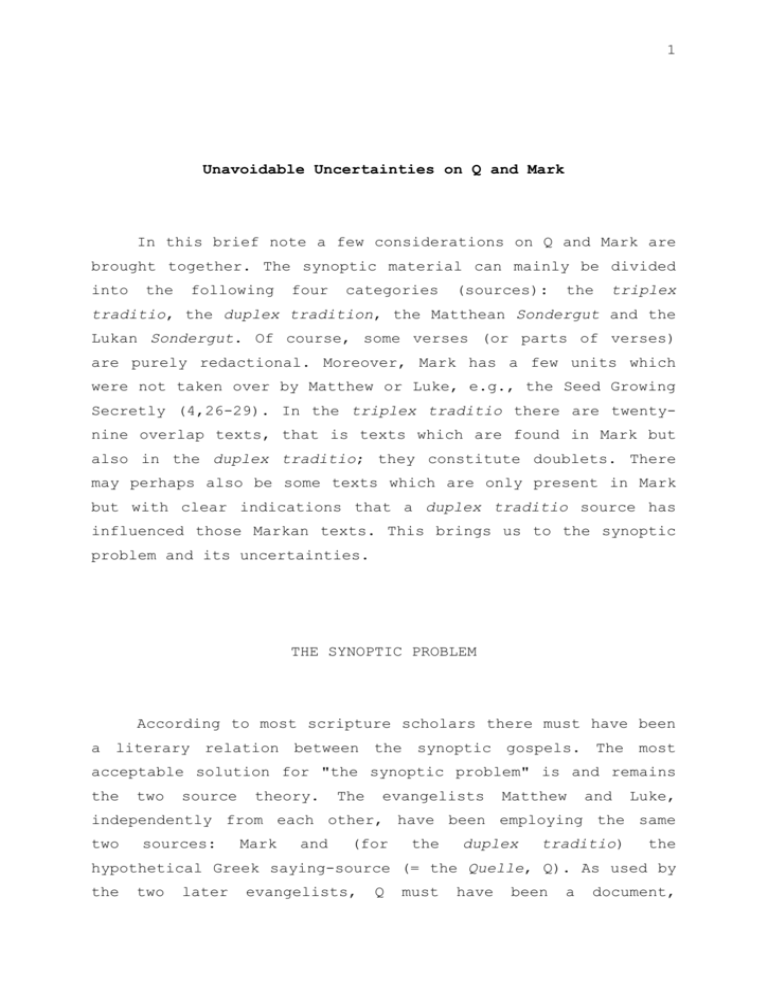
1 Unavoidable Uncertainties on Q and Mark In this brief note a few considerations on Q and Mark are brought together. The synoptic material can mainly be divided into the following four categories (sources): the triplex traditio, the duplex tradition, the Matthean Sondergut and the Lukan Sondergut. Of course, some verses (or parts of verses) are purely redactional. Moreover, Mark has a few units which were not taken over by Matthew or Luke, e.g., the Seed Growing Secretly (4,26-29). In the triplex traditio there are twentynine overlap texts, that is texts which are found in Mark but also in the duplex traditio; they constitute doublets. There may perhaps also be some texts which are only present in Mark but with clear indications that a duplex traditio source has influenced those Markan texts. This brings us to the synoptic problem and its uncertainties. THE SYNOPTIC PROBLEM According to most scripture scholars there must have been a literary relation between the synoptic gospels. The most acceptable solution for "the synoptic problem" is and remains the two source theory. The evangelists Matthew and Luke, independently from each other, have been employing the same two sources: Mark and (for the duplex traditio) the hypothetical Greek saying-source (= the Quelle, Q). As used by the two later evangelists, Q must have been a document, 2 written in Greek. Mark is thus the oldest gospel. Over against Matthew and Luke the Markan priority cannot be negated. Yet for all this absolute certainty cannot be claimed: a theory is not a dogma. THE Q-DOCUMENT The Markan gospel exists. There is no valid reason to suppose that Matthew and/or Luke had before them a substantially different copy from the one we know today. But Q must be reconstructed by careful comparison of the Matthean and Lukan versions of the duplex traditio. A first major uncertainty remains: the content of Q. Is Q perhaps longer than a strict reconstruction proposes? Is there maybe, hidden in the triplex traditio and not by way of a overlap text, one or more pericopes which also belong to Q? Two examples can be offered. a) There is no doubt that Q contains the Announcement of the Coming One (3,7-9), John's Preaching (3,16-17) and the Temptations of Jesus (4,1-13). The Baptism of Jesus is triplex traditio (Mk 1,9-11). Yet in the Temptations the devil twice addresses Jesus by the if-clause: "If you are the Son of God" (Q 4,3 and 9). One is, as it were, forced to assume that Q also contains the antecedent story of Jesus' baptism where a voice from heaven proclaims: "You are my beloved Son" (Mk 1,11). The devil reacts to what the Father says to his Son. If this hypothesis appears to be justified, then it can also be admitted that the Baptist in some way must have been introduced in Q and why, then, not by means of a text as we 3 find in Mk 1,2-4 and 6? So Q at its beginning is most probably longer than the duplex traditio strictly suggests1. b) In Mk 12,18-27 we read the pericope of the Great Commandment. Matthew presents his parallel text in 22,34-40. At Lk 20,40, however, the pericope is absent, but a very similar text is present in Lk 10,25-28. It could be argued that Luke anticipated the triplex traditio text and rewrote it as an introduction (10,29-37). Yet to the parable there are some of minor the Good Samaritan agreements between Matthew and Luke against Mark which seem to indicate that Q possesses its own version of the Great Commandment to be found in Lk 10,25-28 but employed by Matthew as well in his rewriting of Mk 12,18-27. A (too) severe Q-reconstruction on the basis of the duplex tradition omits this pericope in Q. But once again it looks as if the real Q that may have been somewhat longer2. MARK STILL A SOURCE? These two examples lead to a further very important question. If Mark depends on Q, can his gospel itself still be considered as a source? Does the expanded Q not become the only source? H.T. Fleddermann3 and others4 have shown that in Cf. J. LAMBRECHT, "John the Baptist and Jesus in Mark 1,1-15: Markan Redaction of Q?" in NTS 38 (1992) 357-384; reprinted in LAMBRECHT, Understanding What One Reads I. New Testament Essays (1992-2002), Leuven, 2003, pp. 14-42. 2 J. LAMBRECHT, "The Great Commandment Pericope (Mark 12,28-34 and Q 10,2528), in R.A. PIPER (ed.), The Gospel Behind the Gospels. Current Studies on Q, Leiden - New York - Köln, 1995, pp. 73-96; reprinted in LAMBRECHT, Understanding What One Reads I. New Testament Essays (1992-2002), Leuven, 2003, pp. 80-101. 3 H.T. FLEDDERMANN, Mark and Q. A Study of the Overlap Texts. With an Assessment by F. Neirynck (BETL, 122), Leuven, 1995. 1 4 the overlap texts Mark is always secondary and, moreover, that Mark is often dependent verbatim on redactional Q. Those overlap texts represent a substantial part of the Q-document. What about the other Markan texts where minor agreements are present? Yet it would seem that exaggerations here must be avoided. The length of Q, thought somewhat expanded, remains limited. The importance of the minor agreements should not be overly increased. Many can be explained away by an accidentally similar Matthean and Lukan edition. On the other hand, the dogmatic stand about the so-called literary independence of the two sources, Mark and Q, cannot be retained. Mark must have been acquainted with Q; he freely employs it in his gospel. There is, moreover, no reason to state that, in case of knowledge, the absence of great sections of Q cannot be explained. Mark may have been convinced, otherwise than Matthew and Luke, that the existence and availability of a text in his community justified him from rendering and rewriting the whole of that document in his own writing. CONCLUSIONS Several conclusions can be drawn from the insights mentioned above. (1) A final form of Q must have been older than Mark. (2) In the sections where Mark depends on Q the Markan text can be used to reconstruct Q, indeed. The fact that such a work is complex and sophisticated, given the already existing (provisional) reconstruction by comparing the texts I may refer here to several of my studies and notes brought together in the Canonical List at the end of LAMBRECHT, Understanding What One Reads III. New Testament Essays (2011-2014), Leuven, 2014, pp. 4 5 of Matthew and Luke, is and Mark not a reason for neglecting this possibility. (3) Both Q have integrated oral and written traditions. The evangelist Mark, moreover, has also taken up different verses, expressions, words and data from Q. Together with other traditions he composed thus creatively a great number of sections of his gospel. (4) A large margin of uncertainty remains with regard to the Q-document, not only its exact reconstruction, but also its length, structure and hypothetical layers. (5) It would seem that methodologically in this search "Occam's razor" must be applied. One should not too easily postulate entia, be they qualified as "proto-" or "deutero-". The existing Markan gospel and the unavoidably hypthetical Qdocument most probably constitute the solid bases for further reasoning and analysis. (6) And, of course, there is also the large amount of Matthean and Lukan Sondergut.
